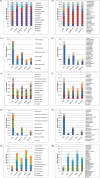N2 Gas Flushing Alleviates the Loss of Bacterial Diversity and Inhibits Psychrotrophic Pseudomonas during the Cold Storage of Bovine Raw Milk
- PMID: 26730711
- PMCID: PMC4701220
- DOI: 10.1371/journal.pone.0146015
N2 Gas Flushing Alleviates the Loss of Bacterial Diversity and Inhibits Psychrotrophic Pseudomonas during the Cold Storage of Bovine Raw Milk
Abstract
The quality and safety of raw milk still remains a worldwide challenge. Culture-dependent methods indicated that the continuous N2 gas-flushing of raw milk reduced the bacterial growth during cold storage by up to four orders of magnitude, compared to cold storage alone. This study investigated the influence of N2 gas-flushing on bacterial diversity in bovine raw-milk samples, that were either cold stored at 6°C or additionally flushed with pure N2 for up to one week. Next-generation sequencing (NGS) of the V1-V2 hypervariable regions of 16S rRNA genes, derived from amplified cDNA, which was obtained from RNA directly isolated from raw-milk samples, was performed. The reads, which were clustered into 2448 operational taxonomic units (OTUs), were phylogenetically classified. Our data revealed a drastic reduction in the diversity of OTUs in raw milk during cold storage at 6°C at 97% similarity level; but, the N2-flushing treatment alleviated this reduction and substantially limited the loss of bacterial diversity during the same cold-storage period. Compared to cold-stored milk, the initial raw-milk samples contained less Proteobacteria (mainly Pseudomonadaceae, Moraxellaceae and Enterobacteriaceae) but more Firmicutes (mainly Ruminococcaceaea, Lachnospiraceae and Oscillospiraceaea) and Bacteroidetes (mainly Bacteroidales). Significant differences between cold-stored and additionally N2-flushed milk were mainly related to higher levels of Pseudomononadaceae (including the genera Pseudomonas and Acinetobacter) in cold-stored milk samples; furthermore, rare taxa were better preserved by the N2 gas flushing compared to the cold storage alone. No major changes in bacterial composition with time were found regarding the distribution of the major 9 OTUs, that dominated the Pseudomonas genus in N2-flushed or non-flushed milk samples, other than an intriguing predominance of bacteria related to P. veronii. Overall, this study established that neither bacteria causing milk spoilage nor any well-known human pathogen or anaerobe benefited from the N2 gas flushing even though the N2-flushed and non-flushed cold-stored milk differed in bacterial counts by up to 104-fold.
Conflict of interest statement
Figures





Similar articles
-
Phospholipolysis Caused by Different Types of Bacterial Phospholipases During Cold Storage of Bovine Raw Milk Is Prevented by N2 Gas Flushing.Front Microbiol. 2018 Jun 19;9:1307. doi: 10.3389/fmicb.2018.01307. eCollection 2018. Front Microbiol. 2018. PMID: 29971053 Free PMC article.
-
The Biodiversity of the Microbiota Producing Heat-Resistant Enzymes Responsible for Spoilage in Processed Bovine Milk and Dairy Products.Front Microbiol. 2017 Mar 1;8:302. doi: 10.3389/fmicb.2017.00302. eCollection 2017. Front Microbiol. 2017. PMID: 28298906 Free PMC article. Review.
-
The contribution of fast growing, psychrotrophic microorganisms on biodiversity of refrigerated raw cow's milk with high bacterial counts and their food spoilage potential.Food Microbiol. 2019 Jun;79:11-19. doi: 10.1016/j.fm.2018.10.019. Epub 2018 Nov 1. Food Microbiol. 2019. PMID: 30621865
-
Molecular analysis of bacterial population structure and dynamics during cold storage of untreated and treated milk.Int J Food Microbiol. 2010 Mar 31;138(1-2):108-18. doi: 10.1016/j.ijfoodmicro.2010.01.008. Epub 2010 Jan 20. Int J Food Microbiol. 2010. PMID: 20137820
-
Psychrotrophic bacteria in milk: How much do we really know?Braz J Microbiol. 2015 Jun 1;46(2):313-21. doi: 10.1590/S1517-838246220130963. eCollection 2015 Jun. Braz J Microbiol. 2015. PMID: 26273245 Free PMC article. Review.
Cited by
-
Pro-Inflammatory versus Immunomodulatory Effects of Silver Nanoparticles in the Lung: The Critical Role of Dose, Size and Surface Modification.Nanomaterials (Basel). 2017 Sep 29;7(10):300. doi: 10.3390/nano7100300. Nanomaterials (Basel). 2017. PMID: 28961222 Free PMC article.
-
Phospholipolysis Caused by Different Types of Bacterial Phospholipases During Cold Storage of Bovine Raw Milk Is Prevented by N2 Gas Flushing.Front Microbiol. 2018 Jun 19;9:1307. doi: 10.3389/fmicb.2018.01307. eCollection 2018. Front Microbiol. 2018. PMID: 29971053 Free PMC article.
-
The Biodiversity of the Microbiota Producing Heat-Resistant Enzymes Responsible for Spoilage in Processed Bovine Milk and Dairy Products.Front Microbiol. 2017 Mar 1;8:302. doi: 10.3389/fmicb.2017.00302. eCollection 2017. Front Microbiol. 2017. PMID: 28298906 Free PMC article. Review.
-
A Review on the Applications of Next Generation Sequencing Technologies as Applied to Food-Related Microbiome Studies.Front Microbiol. 2017 Sep 21;8:1829. doi: 10.3389/fmicb.2017.01829. eCollection 2017. Front Microbiol. 2017. PMID: 29033905 Free PMC article. Review.
-
Efficiency of N2 Gas Flushing Compared to the Lactoperoxidase System at Controlling Bacterial Growth in Bovine Raw Milk Stored at Mild Temperatures.Front Microbiol. 2016 Jun 2;7:839. doi: 10.3389/fmicb.2016.00839. eCollection 2016. Front Microbiol. 2016. PMID: 27313575 Free PMC article.
References
-
- Anonymous 2004: Regulation (EC) No 853/2004 of the European parliament and of the council of 29 april 2004 laying down specific hygiene rules for on the hygiene of foodstuffs. Official J European Union L139/55.
-
- Cousin MA. Presence and activity of psychrotrophic microorganisms in milk and dairy products: a review. J Food Prot. 1982; 45: 172–207. - PubMed
-
- SØrhaug T, Stepaniak L. Psychrotrophs and their enzymes in milk and dairy products: quality aspects. Trends Food Sci Technol. 1997; 8: 35–40.
-
- Frank JF, Hassan AN. Microorganisms associated with milk In: Roginski H, Fuquay JW, Fox PF, editors. Encyclopedia of Dairy Sciences; 2002. pp. 1786–1796.
Publication types
MeSH terms
Substances
LinkOut - more resources
Full Text Sources
Other Literature Sources

